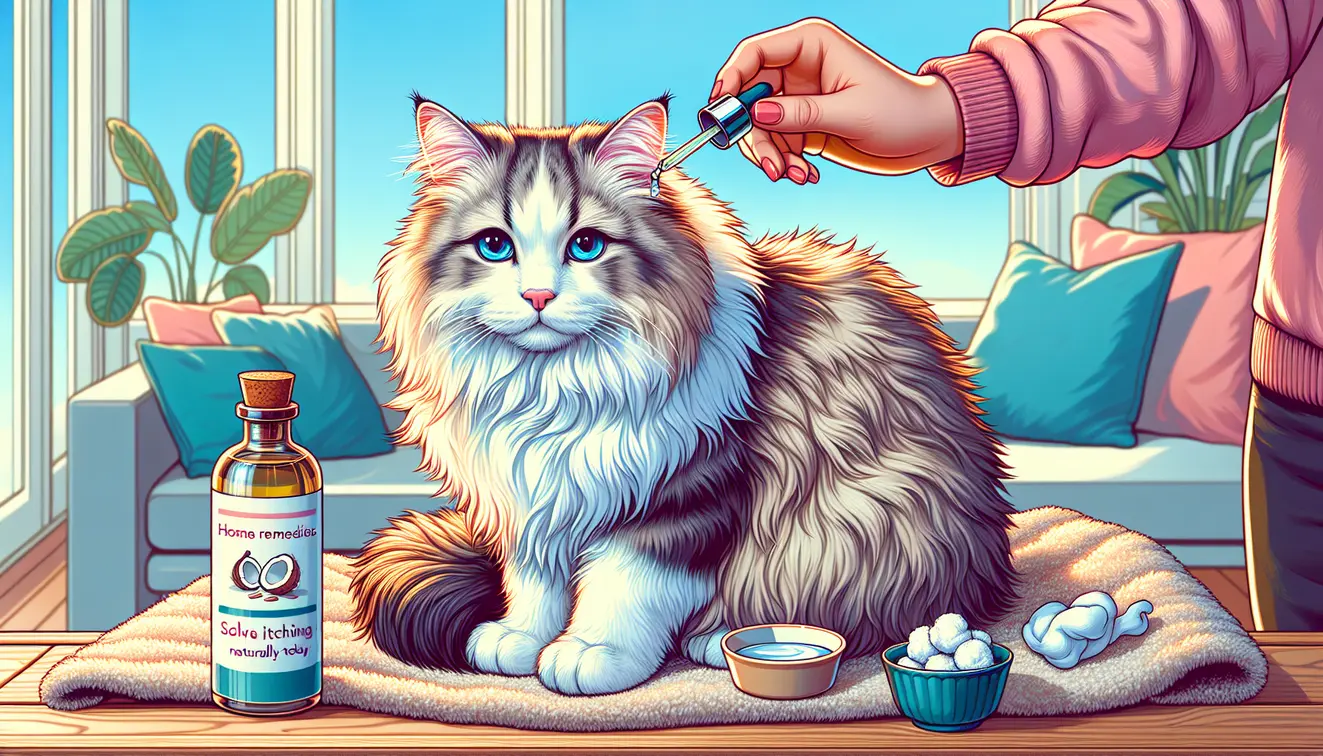Home Remedies for Ear Mites in Cats: Solve Itching Naturally Today
Estimated reading time: 8 minutes
Key Takeaways
- Ear mites are tiny parasites causing itching and irritation in cats, especially kittens and strays.
- Natural remedies like mineral oil, coconut oil, and aloe vera can help manage mild cases.
- Safety is crucial—avoid harmful substances and consult a vet if symptoms persist.
- Prevention through regular ear cleaning and limiting contact with infested animals is key.
Table of Contents
- Introduction to Ear Mites in Cats
- What Are Ear Mites in Cats?
- Signs and Symptoms of Ear Mites in Cats
- Risks of Untreated Ear Mites in Cats
- Safe and Natural Home Remedies for Ear Mites in Cats
- Safety Precautions and Mistakes to Avoid
- When to Seek Veterinary Care for Ear Mites
- Preventing Future Ear Mite Infestations in Cats
- Expert Insights and Credibility for Ear Mite Treatments
- Frequently Asked Questions (FAQs) About Ear Mites in Cats
Introduction to Ear Mites in Cats
If your cat is scratching at their ears or shaking their head more than usual, you might feel a pang of worry. I understand how tough it is to see your furry friend in discomfort. Ear mites, tiny parasites known as Otodectes cynotis, often cause this distress, especially in kittens and outdoor cats.
These minuscule invaders are common, with studies from the ASPCA noting that a significant number of young cats and strays carry them. They settle into the ear canal, triggering irritation that can disrupt your pet’s peace. My goal here is to guide you through safe, natural home remedies rooted in research and veterinary insights to ease your cat’s suffering.
Before we dive in, a gentle reminder: this information is for educational purposes only. It’s not a replacement for professional veterinary care. If your cat’s condition worsens, seeking a vet’s advice is the best step. Let’s explore what ear mites are and how you can help your feline friend find relief naturally.
What Are Ear Mites in Cats?
Ear mites are tiny parasites, scientifically named Otodectes cynotis, that take up residence in a cat’s ear canal. These little creatures feed on ear wax and skin oils, causing intense itching and irritation. They’re especially common in kittens and stray cats who roam outdoors, where exposure to other infested animals happens easily.
Cats often pick up ear mites through direct contact with another infected pet, whether it’s a fellow feline or even a dog. Outdoor environments also pose a risk, as mites can linger in shared spaces. According to the American Veterinary Medical Association (AVMA), these parasites are highly contagious among pets, making early action vital.
Their life cycle is swift—eggs hatch into adults in about three weeks. This rapid turnover means a small problem can grow fast if ignored. Understanding this helps explain why your cat might be so uncomfortable and why we need to tackle the issue promptly. Let’s look at how you can spot these pesky intruders in your pet’s ears.
- Ear mites (Otodectes cynotis) are microscopic parasites living in ear canals.
- Spread occurs via direct contact with infected animals.
- They’re prevalent in young cats and strays.
- Life cycle completes in roughly three weeks, urging quick intervention.
Signs and Symptoms of Ear Mites in Cats
Noticing your cat scratching their ears relentlessly can tug at your heart. Ear mites might be the culprit behind this behavior. These parasites trigger discomfort that’s hard for your pet to ignore, and knowing the signs can help you act swiftly.
You might see your cat shaking their head often or tilting it to one side, as if trying to dislodge something. Check their ears for a dark, crumbly discharge that resembles coffee grounds—a telltale sign of mites. The ear area may also look red or irritated from all the scratching.
There could be subtle shifts in behavior too. Your normally cuddly feline might shy away when you touch near their ears, showing discomfort or irritability. It’s worth noting that these symptoms can mimic other issues like bacterial or yeast infections. Resources from PetMD and VCA Hospitals confirm these signs, helping you pinpoint the problem early for the right care.
- Excessive scratching at the ears.
- Frequent head shaking or tilting.
- Dark, coffee-ground-like discharge in ears.
- Redness or visible irritation.
- Sensitivity or irritability when ears are touched.
Risks of Untreated Ear Mites in Cats
Leaving ear mites unchecked can turn a minor nuisance into a serious concern for your cat. These tiny parasites don’t just cause itching—they pave the way for bigger health issues. Addressing them promptly isn’t just about comfort; it’s about safeguarding your pet’s well-being.
When a cat scratches too much due to mites, the skin can break, inviting bacterial infections. Over time, this constant irritation might even harm their hearing or lead to lasting ear damage. The ASPCA points out that untreated infestations often result in chronic ear troubles that are tougher to resolve.
There’s also the risk of spreading. If you have other pets at home, ear mites can jump from one to another, creating a household-wide problem. Taking action now prevents a cycle of discomfort and potential vet bills down the line. Let’s move forward with solutions that can help nip this issue in the bud. For related insights on dealing with ear mites in other pets, check out this guide on dog ear mites.
- Secondary infections from scratching wounds.
- Potential hearing damage if irritation persists.
- Chronic ear conditions from long-term neglect.
- Spread to other household pets.
Safe and Natural Home Remedies for Ear Mites in Cats
Seeing your cat struggle with ear mites calls for gentle, effective solutions you can try at home. I’ve gathered natural remedies that are safe when used carefully, drawing on veterinary insights and trusted practices. These approaches aim to ease your pet’s itching while tackling the mites, and I’ll guide you through each step with care.
The remedies focus on cleaning the ears and soothing irritation using everyday items like mineral oil or coconut oil. We’ll also explore options such as aloe vera and vet-approved essential oils. Each method comes with clear instructions on application and frequency—often daily for two to three weeks—to match the mites’ life cycle. Studies and vet resources, like those from The Spruce Pets, back the use of certain natural oils for their anti-parasitic effects.
As we go through these, remember that your cat’s safety is paramount. Monitor their response to each remedy, and don’t hesitate to adjust if something doesn’t seem right. Let’s start with the first step: cleaning those ears to loosen debris and begin the healing process.
Initial Ear Cleaning with Mineral or Olive Oil
Cleaning your cat’s ears is a foundational step to combat ear mites. Mineral oil or olive oil works well to soften the crusty debris in the ear canal while helping suffocate the mites. It’s a simple, safe starting point to bring relief.
Here’s how to proceed:
- Gather a small bottle of mineral or olive oil and a soft cloth or cotton ball.
- Warm the oil slightly by holding the bottle in your hands for a minute—never hot.
- Gently hold your cat, wrapping them in a towel if they’re fidgety, to keep them calm.
- Apply a few drops of oil into the ear canal using a dropper or your finger.
- Massage the base of the ear for 30 seconds to loosen debris.
- Let your cat shake their head; this helps dislodge buildup.
- Wipe away excess oil and debris from the outer ear with the cloth—avoid deep insertion.
- Repeat daily for at least a week to ensure progress.
This method helps clear the way for other treatments. Be patient; forcing the process can stress your pet. Always stop if they seem distressed, and keep an eye on how their ears look each day.
Coconut Oil as an Anti-Parasitic Treatment
Coconut oil stands out for its natural anti-parasitic properties, thanks to compounds like lauric acid. It not only helps address ear mites but also soothes the irritated skin in your cat’s ears. This remedy is a gentle way to fight back against those pesky invaders.
Follow these steps carefully:
- Choose pure, unrefined coconut oil without added ingredients.
- Warm a small spoonful by rubbing it between your fingers until it’s a soft liquid.
- Ensure your cat is relaxed, perhaps after a meal, to minimize stress.
- Apply a thin layer inside the ear canal and around the outer ear with your finger.
- Massage gently at the ear base for about 20 seconds to spread the oil.
- Allow your cat to shake out any excess, then wipe the outer ear with a soft cloth.
- Use this daily for two to three weeks to cover the mite life cycle.
Consistency with coconut oil can yield results over time. Veterinary blogs note its effectiveness when paired with regular cleaning. Watch for any unusual reactions, and keep the application light to avoid buildup in the ear.
Aloe Vera for Ear Irritation Relief
Aloe vera offers a calming touch for ears inflamed by mite activity and scratching. Its natural cooling effect can ease your cat’s discomfort while supporting skin recovery. When used right, it’s a safe addition to your care routine.
Here’s how to apply it:
- Use pure, organic aloe vera gel with no added fragrances or chemicals.
- Test a small amount on your cat’s skin elsewhere to rule out sensitivity.
- Hold your cat gently, keeping them secure and calm for the process.
- Scoop a tiny bit of gel with a clean finger or cotton swab.
- Spread it lightly over the irritated areas of the outer ear, avoiding deep inside.
- Massage softly to help the gel absorb into the skin.
- Repeat every other day for a week, observing for improvement.
Aloe vera won’t directly kill mites, but it tackles the irritation they cause. Sources like PetMD suggest it as a supportive measure alongside other treatments. If redness or swelling increases, pause use and reassess your approach to ensure your cat’s comfort.
Diluted Essential Oils with Veterinary Guidance
Certain essential oils, like tea tree or lavender, can help with ear mites when diluted properly. However, cats are highly sensitive to these substances, and incorrect use can harm them. Always consult your vet before trying this remedy to ensure safety.
If approved, follow these steps:
- Confirm the essential oil and dilution ratio with your veterinarian first.
- Typically, mix one drop of oil with a tablespoon of carrier oil like olive oil.
- Test the mixture on a small patch of your cat’s skin for reactions.
- Secure your cat calmly, perhaps with a comforting hold or towel wrap.
- Apply a small amount to the outer ear using a cotton ball, not deep inside.
- Massage lightly to distribute the solution without overwhelming your pet.
- Use only as often as your vet advises, often just a few times weekly.
Veterinary guidance is non-negotiable here, as the ASPCA lists many essential oils as toxic to cats if misused. This method should complement other treatments, not replace them. Stay vigilant for any signs of distress during application.
Safety Precautions and Mistakes to Avoid
Helping your cat with ear mites at home comes with a responsibility to keep them safe. Natural remedies can work wonders, but only when used with caution. I’m here to walk you through pitfalls to dodge, ensuring your pet’s well-being remains the focus.
Steer clear of harmful substances like undiluted vinegar, hydrogen peroxide, or alcohol. These can burn or dry out the delicate ear tissue, worsening the problem. The ASPCA warns against such items, as they’re often toxic or irritating to cats. Also, resist the urge to over-clean or push objects like cotton swabs deep into the ear canal—stick to the outer areas.
With essential oils, err on the side of caution due to potential toxicity if not diluted. Watch for signs of allergic reactions, such as increased redness or swelling. Avoid forcing any treatment if your cat resists; stress can do more harm than good. If symptoms don’t improve, or if something feels off, trust your instincts and pause to reevaluate.
- Skip harmful agents like vinegar or peroxide.
- Don’t insert objects deep into the ear.
- Be cautious with essential oils; dilution is key.
- Stop if allergic reactions or worsening occurs.
When to Seek Veterinary Care for Ear Mites
Home remedies can be a helpful starting point for tackling ear mites, but they’re not always enough. Knowing when to turn to a vet ensures your cat gets the care they need without delay. I’m here to help you recognize those moments with clarity.
If symptoms linger beyond one to two weeks despite your efforts, it’s time for professional help. Look for severe inflammation, bleeding, or a foul odor from the ears—these signal complications. VCA Hospitals notes that such signs often point to secondary infections requiring more than home care.
Sometimes, what seems like ear mites could be another issue, like a yeast infection. A vet can diagnose accurately using a microscope to check ear samples. They might prescribe miticide ear drops or antibiotics to address underlying problems. Remember, these natural solutions complement, not replace, expert care—so don’t hesitate to reach out when needed.
- Persistent symptoms after 1-2 weeks.
- Severe redness, bleeding, or bad odor.
- Possible misdiagnosis of other ear conditions.
- Vet treatments may include prescription ear drops.
Preventing Future Ear Mite Infestations in Cats
Once you’ve tackled ear mites, keeping them at bay becomes the next goal for your cat’s happiness. Prevention is about building simple habits that shield your pet from future discomfort. Let’s explore practical ways to protect those precious ears long-term.
Make ear cleaning a regular part of grooming—once a month with a vet-safe solution works for most cats. If your feline roams outside, try to limit contact with unknown animals who might carry mites. The AVMA suggests this reduces exposure risks significantly. Washing bedding and pet toys often also clears away potential hitchhikers.
If one pet in your home had mites, treat all animals to stop a cycle of reinfestation. Supporting overall health matters too—good nutrition and flea prevention bolster their defenses. These steps, rooted in advice from sources like the ASPCA, weave into daily care, helping ensure your cat stays comfortable and mite-free moving forward. For additional tips on preventing parasitic issues in other pets, see this resource on fleas.
- Clean ears monthly with safe products.
- Limit contact with potentially infested animals.
- Wash bedding and toys regularly.
- Treat all household pets if one is affected.
- Boost health with nutrition and flea control.
Expert Insights and Credibility for Ear Mite Treatments
Navigating ear mite treatments for your cat means leaning on trusted knowledge. I’ve drawn from reliable veterinary sources to ensure the guidance here stands firm. Let’s reinforce why you can feel confident in these natural approaches when paired with caution.
Organizations like the ASPCA and the American Veterinary Medical Association (AVMA) provide foundational insights on ear mite management, emphasizing safety in home care. Veterinary experts often stress that while natural remedies like coconut oil show promise due to anti-parasitic traits, they work best alongside professional input. Resources from PetMD and VCA Hospitals echo this, offering deeper reading on balancing home efforts with vet support.
Quotes from veterinarians, such as advice to “always dilute essential oils and consult before use,” underline the care needed for certain remedies. This content aligns with such expertise, aiming to equip you with informed choices. Rest assured, the path we’ve outlined draws from a well of credible, pet-focused wisdom to guide your next steps.
Frequently Asked Questions (FAQs) About Ear Mites in Cats
Curious about ear mites in cats? I’ve gathered some common questions to clarify lingering doubts. These quick answers aim to round out your understanding with straightforward insights.
Can ear mites spread to humans?
No, ear mites don’t infest humans long-term. They might cause temporary skin irritation if they come into contact, but they can’t survive on us. The ASPCA confirms they stick to pets as their primary hosts.
What exactly are ear mites in cats?
Ear mites, or Otodectes cynotis, are tiny parasites that live in a cat’s ear canal. They feed on wax and oils, causing itching and irritation, especially in kittens or outdoor cats.
Which home remedies work best for kittens versus adult cats?
Kittens need gentler approaches due to sensitive skin—stick to mild cleaning with mineral oil. Adult cats can handle slightly stronger options like coconut oil, though always monitor reactions regardless of age.
How do home remedies compare to veterinary treatments for ear mites?
Home remedies offer a natural first step for mild cases, focusing on cleaning and soothing. Veterinary treatments, like prescription miticides, target mites more directly and address complications, often yielding faster results when needed.










